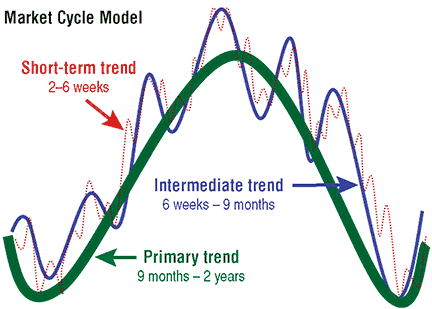INDICATORS
Trends, Triggers, And Reversals
The Special K
Part 1
This indicator points you in the direction of the primary trend, triggers short-term buy & sell signals, and signals reversals in the primary trend at an early stage. In part 1, we look at how to identify the direction of the primary trend.
Recently, I had the opportunity of cowriting a new technical book with my friend and partner, Assad Hamzeh, specifically aimed at Middle Eastern markets. As so often happens during such projects, I came up with what I believe to be a logical extension of the Kst, an indicator that I originally introduced in a series of Technical Analysis of Stocks & Commodities articles in the 1990s.
The Three Trends
Price at any given time is determined by the interaction of numerous time cycles. Figure 1 features three of the most widely recognized ones. The thick green line represents the primary trend, commonly known as bull and bear markets. The bull and bear markets last on average between nine months to two years each and revolve around the four-year business cycle. Markets rarely move in straight lines, so the primary trend is interrupted by intermediate price movements that average between six weeks and nine months. This trend is represented by the blue line. Finally, the red dashed line flags short-term price movements that average between three to six weeks. The Kst formulas I devised were an attempt to represent these three trends in the form of smoothed momentum indicators.

FIGURE 1: market cycle model. Here you see the primary trend, intermediate trend, and short-term price movement.
If you refer back to Figure 1, it’s fairly obvious that the most bullish short-term rallies develop in the lefthand part of the diagram when the primary trend is bullish. Similarly, the short-term trends with the greatest downside magnitude occur on the righthand side during the primary bear market. These are all pro trend moves. One of the most common mistakes made by short-term traders (who trade a span of two to four weeks) is trading against the main (primary) trend. We all know that a rising tide lifts all boats, but we do not always put this adage into practice. That’s because short-term signals that run counter to the primary trend often turn out to be whipsaws or downright unprofitable.